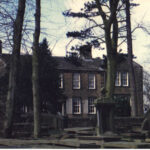Blog Post
Did archaeologists just discover the “signature” of the Prophet Isaiah?
By Jonathon Van Maren
A few years ago, I spent an afternoon deep beneath the City of David, which is about a 45-minute walk from the Jaffa Gate of Jerusalem. I was wading through what is known as Hezekiah’s Tunnel, a narrow underground passageway hewn out of solid rock. The water at times could rise close to your waist as you hunched over, the wet rock pressing against your shoulders on all sides. This was the very same tunnel described in II Chronicles 32:30: “This same Hezekiah also stopped the upper watercourse of Gihon, and brought it straight down to the west side of the city of David. And Hezekiah prospered in all his works.” It is only one of a much larger tunnel system created when Jerusalem was preparing to defend herself against the Assyrian army in the 8th century BC.
It was also this same King Hezekiah who had a close relationship with the biblical prophet Isaiah—and now there may be archaeological evidence of their relationship as well as Scriptural evidence. From the Biblical Archaeology Society:
Excavations in Jerusalem have unearthed what may be the first extra-Biblical evidence of the prophet Isaiah. Just south of the Temple Mount, in the Ophel excavations, archaeologist Eilat Mazar and her team have discovered a small seal impression that reads “[belonging] to Isaiah nvy.” The upper portion of the impression is missing, and its left side is damaged. Reconstructing a few Hebrew letters in this damaged area would cause the impression to read, “[belonging] to Isaiah the prophet.”
If the reconstruction stands, this may be the signature of the Biblical prophet Isaiah—the figure we encounter in the Books of 2 Kings, 2 Chronicles, and Isaiah. Eilat Mazar of the Hebrew University of Jerusalem announces this exciting discovery in her article “Is This the Prophet Isaiah’s Signature?” published in the special March/April/May/June 2018 double issue of Biblical Archaeology Review.
Mazar’s team found the seal impression in an undisturbed area of Iron Age debris (dated to the eighth–seventh centuries B.C.E.) right outside the southeastern wall of the royal bakery, a structure that had been integrated into the city’s fortifications and had operated until the Babylonian destruction of Jerusalem in 586 B.C.E. All of the excavated dirt from this area of the Ophel was wet-sifted, meaning that it was placed on a sifting screen and washed with water. This process revealed multiple finds—including Isaiah’s seal impression and an impression of the Judahite king Hezekiah—which had been missed during traditional excavation methods. Since each of these impressions has a diameter of about half an inch and is the same color as the dirt, it is easy to understand why they were not spotted in the field.
It’s interesting that much of the scepticism that comes whenever an archaeological find seems to confirm some part of the biblical record is almost instinctive. There are many who are committed to the idea that the Scriptures are a collection of fairy tales, due to the earth-shattering implications what would come with the realization that the Scriptures are, in fact, true.
This struck me recently when I was watching a fascinating documentary called Exodus: Patterns of Evidence, which traces one man’s journey to discover whether or not there was any archaeological evidence for the historical account in the biblical book of Exodus. Despite the fact that much evidence existed that almost precisely matched the biblical account, the majority of archaeologists wrote off this evidence—simply because the time period was, in their estimation, incorrect. Thus, evidence that was almost precisely reflective of the biblical narrative was rejected due to chronological calculations by Egyptologists—calculations that are notoriously unreliable. As the filmmaker himself noted:
One amazing part of the evidence that had a big impact on me was found at the very location my crisis of faith had started. A settlement of people was found under the ancient city of Rameses that matched the story of Joseph and his family arriving in Egypt. This evidence had previously not been linked to the Bible because it was from a level that was lower (or older) than what was expected for the Israelites. The settlement started as a few houses of foreigners from the north that were allowed by Egypt to live there – just as Pharaoh allowed Joseph’s family to come in and settle in Egypt. In the middle of this settlement was a Syrian-style house, which was the type of house used in the area of Haran where Joseph’s father Jacob, and his great grandfather Abraham came from. After a while, this house was flattened and on top of it was built a royal palace, however the occupant was not an Egyptian but a high official from the Canaan/Syria area who wore a multi-colored coat. Behind the palace was a cemetery with a pyramid tomb (something usually reserved for Egyptian royals) and 11 other major tombs. All of these discoveries matched the biblical account of Pharaoh rewarding Joseph for saving Egypt and Joseph and his 11 brothers dying and being buried in the land of Egypt. And this is just one of many pieces of evidence I’ve learned about that match the history recorded in the Bible.
You should watch the documentary for yourself, but for me, it seems obvious that if any other ancient book held a narrative that was so precisely mirrored by archaeological evidence, the experts might consider the idea that their timelines could be mistaken or skewed, rather than rejecting a compelling body of evidence that seems to confirm historical events that many seem to have a vested interest in believing are fictional.
____________________________________________
For anyone interested, my book on The Culture War, which analyzes the journey our culture has taken from the way it was to the way it is and examines the Sexual Revolution, hook-up culture, the rise of the porn plague, abortion, commodity culture, euthanasia, and the gay rights movement, is available for sale here.








